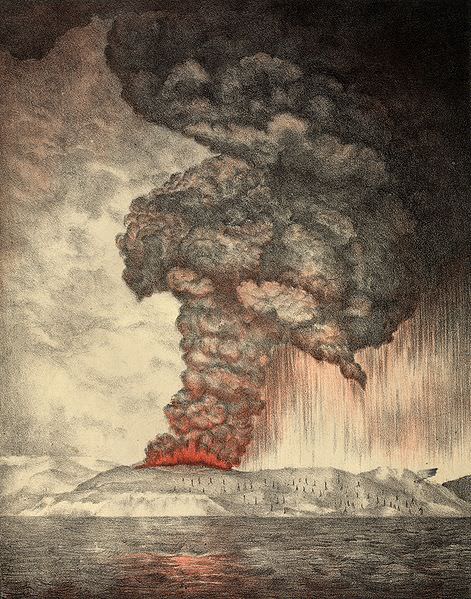[/caption]
Perhaps the most famous volcanic eruption in recent history is the explosion of the volcano Krakatoa in 1883. On August 27 a series of four explosions almost entirely destroyed the island. People as far away as Perth in Western Australia could hear the detonation, and it’s estimated that 120,000 people died from the eruption. In fact, the entire climate of Earth was affected for several years after the eruption, as global temperatures dipped for 5 years.
What’s left of Krakatoa is a small group of islands located in the Sunda Strait, which divides Sumatra from the Island of Java. It’s located directly above the subduction zone of the Eurasian Plate and the Indo-Australian Plate, where the plates make a change in direction. It’s believed that the volcano’s caldera collapsed in 416 AD, forming a 7-km wide caldera. The remnants of this eruption formed Verlaten and Lang Islands. Three volcanoes (Rakata, Danan and Perbuwatan) came together to form the pre-1883 Krakatau island.
Krakatau was made up of one or more stratovolcanoes that went through 5 major periods. The first was an early growth phase, followed by the formation of the caldera. Then the caldera collapsed, and was destroyed during the 1883 eruption. A new growth phase began in December 27, and even now Krakatoa is growing by more than 12 cm/year.
The destruction of Krakatoa began on May 20, 1883 when a mild ash and steam eruptions started up. There were similar eruptions for about 3 months, and at times several vents were erupting at the same time. On August 11, large ash columns rose from the main crater of Perbuwatan. These small eruptions intensified over time, leading to the August 27th explosion that caused the collapse of the caldera.
Although the eruption of Krakatau was devastating, scientists think that many people lost their lives from the giant tsunami generated by the eruption. The largest wave reached 40 meters and killed around 34,000 people. In one case, a ship was carried 2.5 kilometers inland and dumped into the forest.
Scientists measuring the strength of volcanic eruptions using a scale called the Volcanic Explosivity Index (VEI). The eruption at Krakatau measured VEI 6 on the scale, and ejected 16 cubic kilometers of material. Anything within 16 km was covered with 16 meters of ash. Even towns located more than 450 km away were coated with a few cm of ash.
We have written many articles about volcanoes for Universe Today. Here’s an article on Mount Etna, and here’s an article on Mount Vesuvius.
Want more resources on the Earth? Here’s a link to NASA’s Human Spaceflight page, and here’s NASA’s Visible Earth.
We have also recorded an episode of Astronomy Cast about Earth, as part of our tour through the Solar System – Episode 51: Earth.
References:
http://vulcan.wr.usgs.gov/Volcanoes/Indonesia/description_krakatau_1883_eruption.html
http://hvo.wr.usgs.gov/volcanowatch/2003/03_05_22.html

